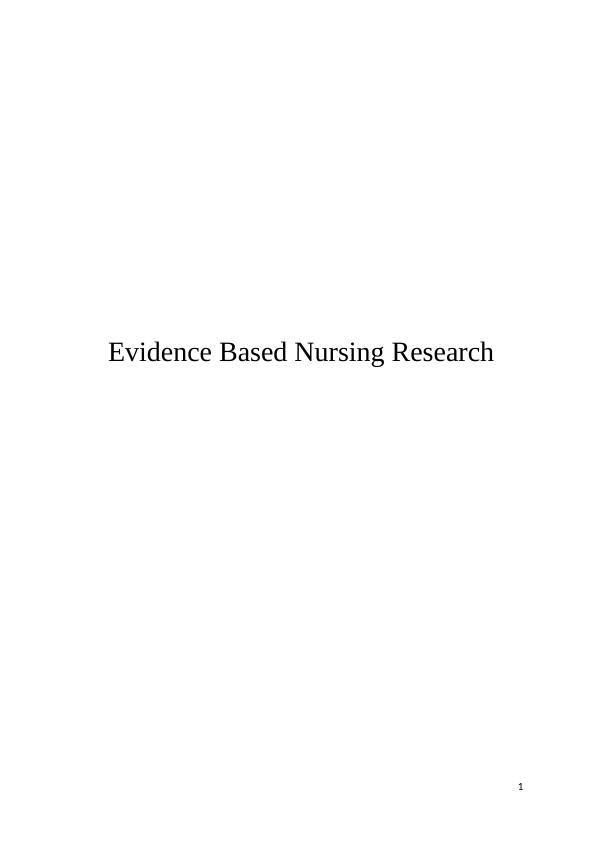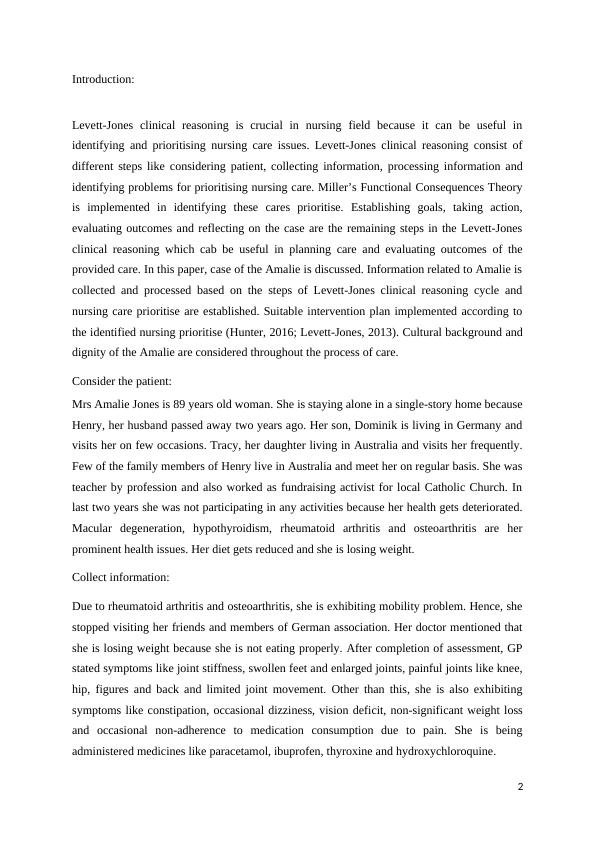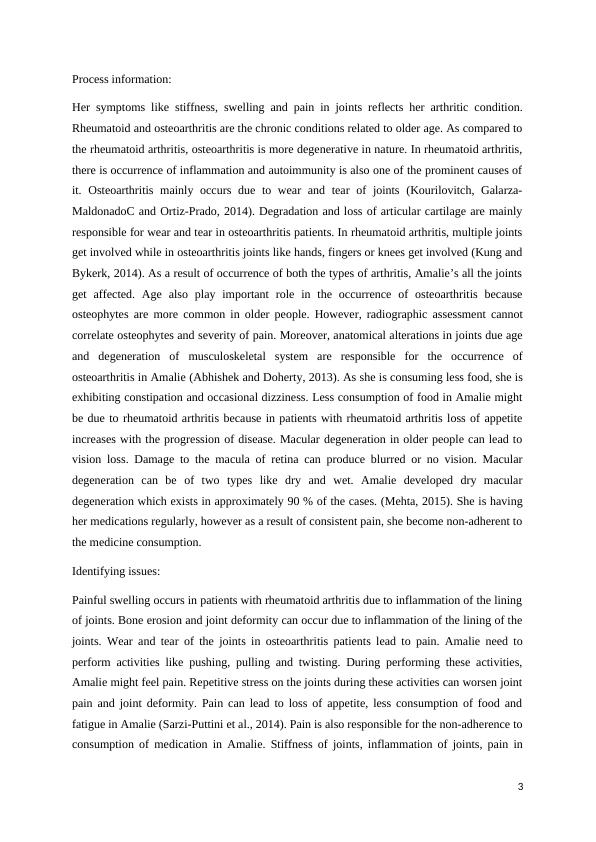Levett-Jones Clinical Reasoning Cycle for Nursing Care Prioritization: A Case Study of Amalie
Added on 2023-06-13
7 Pages2623 Words101 Views
Evidence Based Nursing Research
1
1

Introduction:
Levett-Jones clinical reasoning is crucial in nursing field because it can be useful in
identifying and prioritising nursing care issues. Levett-Jones clinical reasoning consist of
different steps like considering patient, collecting information, processing information and
identifying problems for prioritising nursing care. Miller’s Functional Consequences Theory
is implemented in identifying these cares prioritise. Establishing goals, taking action,
evaluating outcomes and reflecting on the case are the remaining steps in the Levett-Jones
clinical reasoning which cab be useful in planning care and evaluating outcomes of the
provided care. In this paper, case of the Amalie is discussed. Information related to Amalie is
collected and processed based on the steps of Levett-Jones clinical reasoning cycle and
nursing care prioritise are established. Suitable intervention plan implemented according to
the identified nursing prioritise (Hunter, 2016; Levett-Jones, 2013). Cultural background and
dignity of the Amalie are considered throughout the process of care.
Consider the patient:
Mrs Amalie Jones is 89 years old woman. She is staying alone in a single-story home because
Henry, her husband passed away two years ago. Her son, Dominik is living in Germany and
visits her on few occasions. Tracy, her daughter living in Australia and visits her frequently.
Few of the family members of Henry live in Australia and meet her on regular basis. She was
teacher by profession and also worked as fundraising activist for local Catholic Church. In
last two years she was not participating in any activities because her health gets deteriorated.
Macular degeneration, hypothyroidism, rheumatoid arthritis and osteoarthritis are her
prominent health issues. Her diet gets reduced and she is losing weight.
Collect information:
Due to rheumatoid arthritis and osteoarthritis, she is exhibiting mobility problem. Hence, she
stopped visiting her friends and members of German association. Her doctor mentioned that
she is losing weight because she is not eating properly. After completion of assessment, GP
stated symptoms like joint stiffness, swollen feet and enlarged joints, painful joints like knee,
hip, figures and back and limited joint movement. Other than this, she is also exhibiting
symptoms like constipation, occasional dizziness, vision deficit, non-significant weight loss
and occasional non-adherence to medication consumption due to pain. She is being
administered medicines like paracetamol, ibuprofen, thyroxine and hydroxychloroquine.
2
Levett-Jones clinical reasoning is crucial in nursing field because it can be useful in
identifying and prioritising nursing care issues. Levett-Jones clinical reasoning consist of
different steps like considering patient, collecting information, processing information and
identifying problems for prioritising nursing care. Miller’s Functional Consequences Theory
is implemented in identifying these cares prioritise. Establishing goals, taking action,
evaluating outcomes and reflecting on the case are the remaining steps in the Levett-Jones
clinical reasoning which cab be useful in planning care and evaluating outcomes of the
provided care. In this paper, case of the Amalie is discussed. Information related to Amalie is
collected and processed based on the steps of Levett-Jones clinical reasoning cycle and
nursing care prioritise are established. Suitable intervention plan implemented according to
the identified nursing prioritise (Hunter, 2016; Levett-Jones, 2013). Cultural background and
dignity of the Amalie are considered throughout the process of care.
Consider the patient:
Mrs Amalie Jones is 89 years old woman. She is staying alone in a single-story home because
Henry, her husband passed away two years ago. Her son, Dominik is living in Germany and
visits her on few occasions. Tracy, her daughter living in Australia and visits her frequently.
Few of the family members of Henry live in Australia and meet her on regular basis. She was
teacher by profession and also worked as fundraising activist for local Catholic Church. In
last two years she was not participating in any activities because her health gets deteriorated.
Macular degeneration, hypothyroidism, rheumatoid arthritis and osteoarthritis are her
prominent health issues. Her diet gets reduced and she is losing weight.
Collect information:
Due to rheumatoid arthritis and osteoarthritis, she is exhibiting mobility problem. Hence, she
stopped visiting her friends and members of German association. Her doctor mentioned that
she is losing weight because she is not eating properly. After completion of assessment, GP
stated symptoms like joint stiffness, swollen feet and enlarged joints, painful joints like knee,
hip, figures and back and limited joint movement. Other than this, she is also exhibiting
symptoms like constipation, occasional dizziness, vision deficit, non-significant weight loss
and occasional non-adherence to medication consumption due to pain. She is being
administered medicines like paracetamol, ibuprofen, thyroxine and hydroxychloroquine.
2

Process information:
Her symptoms like stiffness, swelling and pain in joints reflects her arthritic condition.
Rheumatoid and osteoarthritis are the chronic conditions related to older age. As compared to
the rheumatoid arthritis, osteoarthritis is more degenerative in nature. In rheumatoid arthritis,
there is occurrence of inflammation and autoimmunity is also one of the prominent causes of
it. Osteoarthritis mainly occurs due to wear and tear of joints (Kourilovitch, Galarza-
MaldonadoC and Ortiz-Prado, 2014). Degradation and loss of articular cartilage are mainly
responsible for wear and tear in osteoarthritis patients. In rheumatoid arthritis, multiple joints
get involved while in osteoarthritis joints like hands, fingers or knees get involved (Kung and
Bykerk, 2014). As a result of occurrence of both the types of arthritis, Amalie’s all the joints
get affected. Age also play important role in the occurrence of osteoarthritis because
osteophytes are more common in older people. However, radiographic assessment cannot
correlate osteophytes and severity of pain. Moreover, anatomical alterations in joints due age
and degeneration of musculoskeletal system are responsible for the occurrence of
osteoarthritis in Amalie (Abhishek and Doherty, 2013). As she is consuming less food, she is
exhibiting constipation and occasional dizziness. Less consumption of food in Amalie might
be due to rheumatoid arthritis because in patients with rheumatoid arthritis loss of appetite
increases with the progression of disease. Macular degeneration in older people can lead to
vision loss. Damage to the macula of retina can produce blurred or no vision. Macular
degeneration can be of two types like dry and wet. Amalie developed dry macular
degeneration which exists in approximately 90 % of the cases. (Mehta, 2015). She is having
her medications regularly, however as a result of consistent pain, she become non-adherent to
the medicine consumption.
Identifying issues:
Painful swelling occurs in patients with rheumatoid arthritis due to inflammation of the lining
of joints. Bone erosion and joint deformity can occur due to inflammation of the lining of the
joints. Wear and tear of the joints in osteoarthritis patients lead to pain. Amalie need to
perform activities like pushing, pulling and twisting. During performing these activities,
Amalie might feel pain. Repetitive stress on the joints during these activities can worsen joint
pain and joint deformity. Pain can lead to loss of appetite, less consumption of food and
fatigue in Amalie (Sarzi-Puttini et al., 2014). Pain is also responsible for the non-adherence to
consumption of medication in Amalie. Stiffness of joints, inflammation of joints, pain in
3
Her symptoms like stiffness, swelling and pain in joints reflects her arthritic condition.
Rheumatoid and osteoarthritis are the chronic conditions related to older age. As compared to
the rheumatoid arthritis, osteoarthritis is more degenerative in nature. In rheumatoid arthritis,
there is occurrence of inflammation and autoimmunity is also one of the prominent causes of
it. Osteoarthritis mainly occurs due to wear and tear of joints (Kourilovitch, Galarza-
MaldonadoC and Ortiz-Prado, 2014). Degradation and loss of articular cartilage are mainly
responsible for wear and tear in osteoarthritis patients. In rheumatoid arthritis, multiple joints
get involved while in osteoarthritis joints like hands, fingers or knees get involved (Kung and
Bykerk, 2014). As a result of occurrence of both the types of arthritis, Amalie’s all the joints
get affected. Age also play important role in the occurrence of osteoarthritis because
osteophytes are more common in older people. However, radiographic assessment cannot
correlate osteophytes and severity of pain. Moreover, anatomical alterations in joints due age
and degeneration of musculoskeletal system are responsible for the occurrence of
osteoarthritis in Amalie (Abhishek and Doherty, 2013). As she is consuming less food, she is
exhibiting constipation and occasional dizziness. Less consumption of food in Amalie might
be due to rheumatoid arthritis because in patients with rheumatoid arthritis loss of appetite
increases with the progression of disease. Macular degeneration in older people can lead to
vision loss. Damage to the macula of retina can produce blurred or no vision. Macular
degeneration can be of two types like dry and wet. Amalie developed dry macular
degeneration which exists in approximately 90 % of the cases. (Mehta, 2015). She is having
her medications regularly, however as a result of consistent pain, she become non-adherent to
the medicine consumption.
Identifying issues:
Painful swelling occurs in patients with rheumatoid arthritis due to inflammation of the lining
of joints. Bone erosion and joint deformity can occur due to inflammation of the lining of the
joints. Wear and tear of the joints in osteoarthritis patients lead to pain. Amalie need to
perform activities like pushing, pulling and twisting. During performing these activities,
Amalie might feel pain. Repetitive stress on the joints during these activities can worsen joint
pain and joint deformity. Pain can lead to loss of appetite, less consumption of food and
fatigue in Amalie (Sarzi-Puttini et al., 2014). Pain is also responsible for the non-adherence to
consumption of medication in Amalie. Stiffness of joints, inflammation of joints, pain in
3

End of preview
Want to access all the pages? Upload your documents or become a member.
Related Documents
Levett-Jones Clinical Reasoning Cycle: A Case Study on Nursing Prioritizationlg...
|8
|3017
|492
Promoting Health in Extended Carelg...
|8
|2888
|435
Promoting Health in Extended Carelg...
|8
|2885
|293
Case Study of Mrs. Jones: Clinical Reasoning Cycle and Miller's Functional Consequences Theorylg...
|9
|2646
|296
Clinical Reasoning Cycle for Geriatric Patient with Mobility Impairmentlg...
|10
|3112
|109
Promoting Health in Extended Carelg...
|10
|2774
|290